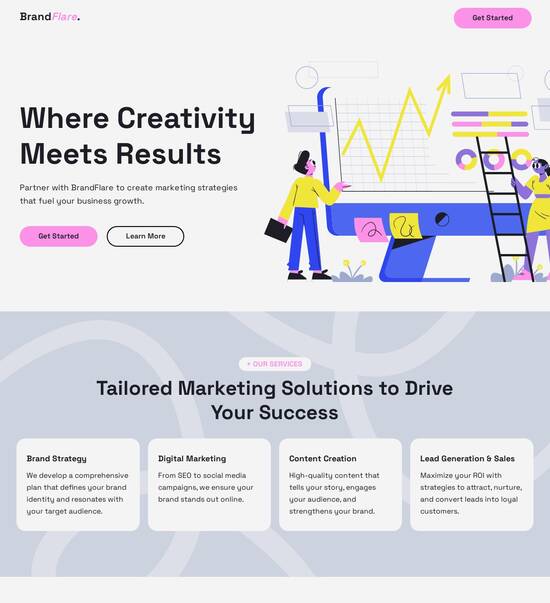
Next.js optimized GDPR compliance page template
Explore Similar TemplatesAbout template
Supercharge your GDPR compliance page with Next.js for outstanding performance! Learn more today.
Recommended templates

Easy to build without coding
With the intuitive drag-and-drop builder, anyone on your team can create high-converting pages without any knowledge of code or design. Make enhancements to your landing page with custom widgets using Javascript, HTML/CSS, or third-party scripts.

Multiple layouts for any industry and goal
Select from 500+ landing page layouts built to boost conversions across industry-specific scenarios. Customize them by adjusting fonts, adding images, and generating on-brand content with the AI assistant. Quickly scale with Instablocks® and Global Blocks that you can save, reuse, and update globally.

Loads fast and looks polished on any device
Every template is responsive, which means they present professionally on any device and load blazingly fast with our Thor Render Engine. You can also power them up with Google AMP technology to deliver an unparalleled mobile experience and drive higher conversions.

Robust analytics & experimentation
Get real-time updates and reporting across all your devices, showing the number of visitors, conversions, cost-per-visitor, and cost-per-lead. Launch AI-powered experiments, run A/B tests, and use heatmaps to analyze user behavior, then optimize your landing page to maximize conversions.







Easy to build without coding
With the intuitive drag-and-drop builder, anyone on your team can create high-converting pages without any knowledge of code or design. Make enhancements to your landing page with custom widgets using Javascript, HTML/CSS, or third-party scripts.
Multiple layouts for any industry and goal
Select from 500+ landing page layouts built to boost conversions across industry-specific scenarios. Customize them by adjusting fonts, adding images, and generating on-brand content with the AI assistant. Quickly scale with Instablocks® and Global Blocks that you can save, reuse, and update globally.
Loads fast and looks polished on any device
Every template is responsive, which means they present professionally on any device and load blazingly fast with our Thor Render Engine.
Robust analytics & experimentation
Get real-time updates and reporting across all your devices, showing the number of visitors, conversions, cost-per-visitor, and cost-per-lead. Launch AI-powered experiments, run A/B tests, and use heatmaps to analyze user behavior, then optimize your landing page to maximize conversions.
All the features you need to build next js 500 page
Explore more featuresLearn how to build nextjs 500 page
FAQs
Leading the way in building high-performing landing pages





A step-by-step guide to using Instapage effectively for landing page creation
Instapage is the most powerful landing page and CRO platform designed to boost your digital marketing campaigns' effectiveness. This guide will walk you through the essential steps to leverage Instapage capabilities, maximize ROI, and enhance your landing pages. With its user-friendly interface and powerful features, you can create high-converting landing pages tailored to every audience without any coding experience.
Understanding the importance of landing pages
Landing pages play a crucial role in converting visitors to leads or customers. A well-designed page can significantly lower your cost per acquisition and increase the return on your marketing investments. Instapage offers a flexible platform, complete with over 100 high-converting templates, making it simple for marketers in various industries like business services, tech/SaaS, and education to get started on effective campaigns quickly.
- High-converting templates: Choose from 100+ designs tailored for optimal performance based on industry best practices.
- User-friendly interface: Effortlessly create landing pages with intuitive drag-and-drop tools without needing technical skills.
- Integration capabilities: Connect your existing marketing tools and CRMs to streamline your workflow and boost efficiency.
Step 1: Select the right template
Your first step in creating a landing page using Instapage is selecting a template that aligns with your campaign goals. With a variety of customizable options available, choosing the right one can save you time and enhance your design quality. Consider using templates with elements specifically designed for lead generation.
- Lead capture forms: Ensure your template includes strategically placed forms to capture visitor information.
- Clear call-to-action: Opt for designs that emphasize actionable buttons leading users towards desired actions.
- Mobile responsiveness: Select templates that automatically adjust to various device sizes, ensuring a seamless user experience.
Step 2: Optimize for conversion
Once you've selected a template, the next step is to optimize it for conversions. Utilize Instapage's built-in experimentation features, such as A/B testing and heatmaps, to analyze user behavior. This phase is crucial for identifying what resonates with your audience and what needs improvement.
- A/B testing: Run experiments to compare variants of your landing page and choose the one with the best performance.
- Heatmaps: Use heatmapping tools to visualize where visitors are clicking and adjust your design accordingly.
- Analytics dashboard: Regularly assess the performance of your landing pages with comprehensive analytics to make data-driven decisions.
Step 3: Personalize your content
To enhance user engagement, personalizing content for different audience segments is vital. Utilize Instapage's dynamic text replacement and AdMaps features to tailor experiences to specific customer personas. This will greatly increase your potential for conversion by delivering relevant messages.
In summary, by following these steps, you can effectively harness the power of Instapage to create high-performance landing pages tailored to your market needs.
Ready to take your marketing campaigns to the next level? Start using Instapage today and experience the transformation of your lead generation process.
Next.js optimized GDPR compliance page template
Understanding GDPR compliance in the digital landscape
The General Data Protection Regulation (GDPR) is a crucial regulation for any business operating within or marketing to consumers in the European Union. Enforced since May 2018, it establishes strict guidelines regarding data collection and privacy, mandating that companies take accountability for their data handling practices. Failure to comply can result in hefty fines, making GDPR compliance a top priority for businesses.
GDPR significantly impacts user privacy by introducing comprehensive data protection standards that aim to safeguard personal information. This includes requiring companies to gain explicit consent from users before collecting their data, offering individuals the right to access their personal information, and ensuring secure transmission and storage of this data.
Moreover, GDPR emphasizes the importance of transparent and user-friendly consent mechanisms. Businesses must adopt clear language and straightforward processes to obtain user consent, empowering individuals to make informed choices about their data. By establishing trust through compliance, companies can enhance their reputations and compete more effectively.
The role of Next.js in modern web development
Next.js is a powerful React framework that provides developers with the tools to build optimized web applications. With its server-side rendering (SSR) and static site generation (SSG) capabilities, Next.js allows for faster page loads and improved performance, which are vital for providing a seamless user experience. As a result, it is increasingly favored for applications that require compliance with regulations like GDPR.
One of Next.js's unique features is its API routes, enabling developers to build backend functionalities within the same framework. This integration facilitates the management of data directly from the application, making it easier to implement GDPR-compliant data handling practices.
With its built-in support for TypeScript and CSS modules, Next.js equips developers with various tools that streamline the development process. Consequently, businesses can prioritize compliance-focused applications without sacrificing code quality or organization, thus making Next.js a top choice for user-centric development.
Crafting an optimized GDPR compliance page with Next.js
An effective GDPR compliance page should encompass several key components designed to meet regulatory standards and enhance user understanding. First, a clear and concise privacy policy must outline the types of personal data collected, purposes of collection, and how this data is processed. This transparency helps build trust between users and businesses.
Next, explicit consent forms are crucial. These should include checkboxes requiring users to actively agree to data collection practices. Using clear, affirmative language conveys the seriousness of user consent, steering away from pre-checked boxes or vague terms.
Clear and concise privacy policy
Explicit consent forms with checkboxes
User-friendly opt-out options
Utilizing Next.js's features can significantly enhance the functionality of the compliance page. For instance, dynamic routing can create tailored user experiences, allowing businesses to present specific information relevant to different audience segments. Moreover, server-side rendering ensures that SEO remains intact, allowing these pages to be discoverable without performance issues.
Leveraging advanced technologies for GDPR compliance
To bolster compliance efforts, businesses can integrate various tools with Next.js. One essential tool is cookie consent management software. These tools help manage user consents for cookies and other tracking technologies, offering features that automatically block scripts until consent is granted.
Additionally, data encryption and secure storage solutions play a pivotal role in safeguarding user data. Companies should implement such technologies to protect personal data from breaches and unauthorized access. Understanding the role of APIs in handling compliance data is equally important; they should be designed to securely transmit and manage any personal information collected.
Navigating the GDPR landscape with community insights
Participating in developer communities can significantly enhance the understanding and execution of GDPR compliance. Engaging with fellow developers through forums, GitHub discussions, and dedicated Discord channels provides valuable insights into best practices and challenges faced during implementation.
Moreover, collective knowledge-sharing platforms like Stack Overflow facilitate quick problem resolution and enable continuous learning. Online workshops and webinars focused on GDPR compliance can also offer practical guidance, arming developers with the knowledge needed to navigate this intricate regulatory landscape.
The content strategy behind a winning GDPR compliance page
To ensure clarity and transparency, the content on a GDPR compliance page must utilize simple language while avoiding jargon. Users should easily comprehend the information presented without feeling overwhelmed or confused. Including a dedicated Frequently Asked Questions (FAQ) section can also serve to address common queries, further enhancing user understanding.
Additionally, regularly updating the blog can play an integral role in keeping users informed about policy changes and best practices. This not only demonstrates a commitment to transparency but also fosters an environment of trust, allowing businesses to strengthen relationships with their audience.
Building and sustaining a GDPR compliance team
Creating an effective GDPR compliance team is crucial for maintaining compliance standards over time. Key characteristics include understanding data privacy laws, technical expertise, and the ability to communicate effectively across departments. Team members must be diligent and proactive to catch compliance issues before they escalate.
Role delineation is essential; appoint specific members to create and regularly update the compliance page, while others focus on outreach, user education, and feedback collection. Collaborative tools foster a smooth workflow, enabling the team to coordinate efforts in monitoring compliance effectively.
Location-based compliance considerations
GDPR compliance also requires attention to global contexts. Different regions may have varying laws that impact how data is handled. Customizing content based on user locations ensures that compliance information remains accurate and relevant, directly addressing the regulatory environments of different jurisdictions.
Companies must navigate these complexities carefully, incorporating region-specific considerations into their GDPR strategies. Understanding implications from regional laws will help organizations mitigate risks and strengthen overall compliance efforts.
Enhancing user engagement through GDPR practices
Engaging users with clear consent information is critical. Utilizing visually appealing designs and straightforward language can help ensure that users understand what they are consenting to. Creating an inviting environment facilitates better interactions and encourages users to participate willingly.
Moreover, maintaining transparency about data collection and usage is vital. Regularly analyzing user feedback can provide insights into potential improvements, while making it easy for users to opt-in or opt-out of specific data collections can further enhance the user experience.
Employing analytics to monitor compliance effectiveness
Tracking metrics is essential for maintaining an effective GDPR compliance strategy. Consent rates can reveal the effectiveness of recruitment practices, while bounce rates may indicate areas that require optimization. By evaluating opt-in and opt-out patterns, businesses can continuously refine their strategies based on real data.
Utilizing Next.js analytics tools enables developers to gain invaluable insights into user behavior. A/B testing is particularly effective for optimizing consent forms and improving information accessibility, ultimately leading to better user experiences.
The future of GDPR compliance with Next.js developments
As web technologies continue to evolve, anticipating upcoming trends in privacy regulations is crucial for staying compliant. Integrating artificial intelligence and machine learning can enhance user data analysis, offering deeper insights into consumer behavior and preferences.
Moreover, keeping an eye on potential updates in Next.js functionalities will keep businesses ready to adapt to changing compliance needs. By leveraging upcoming features, organizations can streamline their GDPR compliance efforts while maintaining operational efficiency.
Previews and showcases: successful implementation stories
Case studies from various businesses illustrate how Next.js can streamline GDPR compliance efforts. Companies have reported improvements in speed and performance through the integration of Next.js, enabling faster page loads and more effective data handling. These successful implementations highlight the importance of continuous iteration and responsiveness to user feedback in shaping compliance strategies.
Analyzing best practices from these case studies can guide other organizations in achieving their compliance goals without hinderance. Sharing successes within the community reinforces that GDPR compliance is attainable, motivating more teams to embrace necessary changes.
Connecting with the right resources for ongoing learning
Staying updated with GDPR regulations and Next.js developments is vital for compliance success. Regularly following recommended blogs, newsletters, and joining online communities can enrich knowledge and skills, keeping teams agile and informed.
Engaging in courses and certification programs focusing on GDPR compliance and Next.js can further enhance team capabilities. Such investments will not only reinforce the knowledge base within the organization but also demonstrate a commitment to maintaining stringent privacy standards.
Ready to skyrocket conversions?
Supercharge your ad campaigns with high-performing landing pages
Get started














